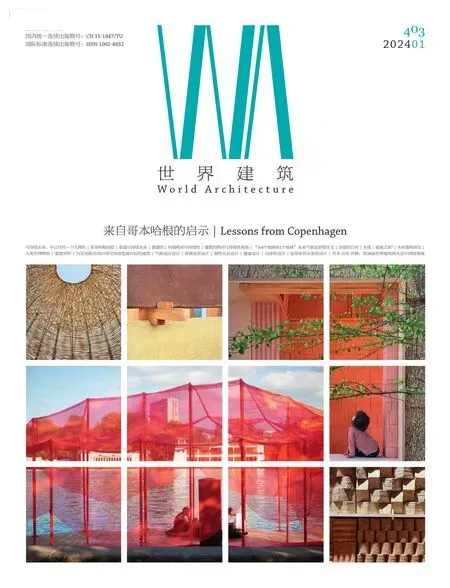哥本哈根经验
——建立10项原则
娜塔莉·莫辛
2023 年7 月在哥本哈根举行的国际建筑师协会第28 届世界建筑师大会“可持续的未来——不让任何 一个人掉队”的闭幕式上推出“哥本哈根经验”。
哥本哈根经验是在过去6 年以及世界建筑师大会期间积累的全球经验、不同的声音、杰出的新研究和实践的基础上发展起来的。这些活动共同探讨了建筑为联合国可持续发展目标贡献的潜力和需求。
哥本哈根经验的制定是希望这些经验能成为鼓舞人心的原则,为可持续的未来奠定基础。这些原则的制定在联合国可持续发展目标和建成环境领域之间发挥桥梁作用,但始终支持跨越地域、文化和环境的本土化应用的探索。
这些原则大胆甚至激进,难以完全实施。这反映了我们在实现社会和环境可持续性、确保所有人的尊严和尊重地球边界的建筑环境中所面临的巨大挑战。当我们将这些原则运用到建筑设计、规划过程和施工现场时,这些原则涉及我们必须实现的抱负,并为我们讨论其在当地实践中的意义奠定基础。
这些原则推动了新材料实践的需求,更重要的是,推动了对建筑美学和伦理的新思考:每一次,我们都必须知道我们为什么要建造,我们必须积极反思这些行动如何为关爱人类和地球做出贡献。
哥本哈根经验 1)
(1)所有人的尊严和能动性是建筑的根本,排斥行为毫无美感可言;
(2)在我们建设、规划和开发建筑环境时,必须首先为有可能掉队的人提供便利;
(3)必须首先重新利用现有的建筑结构;
(4)任何新的发展都不能抹杀绿地;
(5)无论建筑环境如何,都必须维持自然生态系统和粮食生产;
(6)如果可以重复使用,在施工中不允许使用原生矿物材料;
(7)施工中不得生产或留下任何废物;
(8)在采购建筑材料时,本地可再生材料是首选;
(9)在我们建造的所有东西中,碳捕集必须超过碳足迹;
(10)在开发、规划和建设建筑环境时,每项活动都必须对水生态系统和清洁水供应产生积极影响。

1 哥本哈根经验横标 Copenhagen Lessons banner
Copenhagen Lessons were presented at the closing ceremony of the 28th UIA World Congress of Architects,"Sustainable Futures -Leave No One Behind",which was held in July 2023 in Copenhagen.
Copenhagen Lessons build upon the global experiences,diverse voices,outstanding new research,and practices brought together over the 6 years leading up to -and during -the UIA World Congress of Architects.Altogether,these activities have explored the potential and need for architecture's contributions to the UN Sustainable Development Goals.
Copenhagen Lessons are formulated with the hope that they can serve as inspirational principles to build on for a sustainable future.They are formulated as principles,bridging from the UN Sustainable Development Goals to the domain of the built environment,but kept overarching to support the exploration of a localised application across geographies,cultures,and conditions.
The principles are bold,even radical,and are not easy to apply in full.This reflects the enormity of the challenges we face within the built environment to reach social and environmental sustainability,to ensure dignity for all and to respect the planetary boundaries.The principles address the boldness of what we must achieve,for and provides a foundation for conversations about what this means in local practice,when we apply the principles to our building designs,planning processes and construction sites.
The principles push forward the need for a new material practice,and not least,a new aesthetic and ethical thinking in architecture: we must know why we build,every time,and we must actively reflect upon how these actions honours care for people and the planet.
Copenhagen Lessons1)
(1) Dignity and agency for all people is fundamental in architecture,there is no beauty in exclusion.
(2) People at risk of being left behind must be accommodated first when we construct,plan,and develop the built environment.
(3) Existing built structures must always be reused first.
(4) No new development must erase green fields.
(5) Natural ecosystems and food production must be sustained regardless of the build context.(6) No virgin mineral material must be used in construction,when reuse is possible.
(7) No waste must be produced or left behind in construction.
(8) When sourcing materials for construction,local renewable materials come first.
(9) In everything we build,carbon capture must exceed carbon footprint.
(10) When developing,planning,and constructing the built environment,every activity must have a positive impact on water ecosystems and clean water supply.

